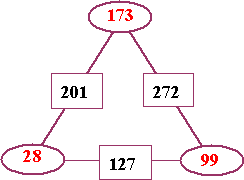Number juggle
Fill in the missing numbers so that adding each pair of corner
numbers gives you the number between them (in the box).
Problem
Fill in the missing numbers so that adding each pair of corner numbers gives you the number in the box between them.
Image

Getting Started
What numbers could you try to start with?
What happens if you make one of the numbers smaller?
What happens if you make one of the numbers larger?
What happens if you make one of the numbers smaller?
What happens if you make one of the numbers larger?
Student Solutions
Correct solutions were sent in by Jade and Sarah from Willaston Primary School, Isle Of Man and Gemma from Annesley College, South Australia
Image

Annabelle also from Annesley College, South Australia explained the process:
"We started with the 90's because it was less then 100 but still close to the numbers in the box. We tried all different starting points and ended up with 99. To see if 99 worked we took 99 from 127 which gave us 28. Then we took 28 from 201 which gave us 173."
Teachers' Resources
Why do this problem?
At the very simplest level
this is an investigation involving estimation and trial and
improvement. The greater depth comes from realising that changing
any one corner number affects two others and that this means
keeping two conditions in mind simultaneously.
Key questions
What would be good 'rough' numbers to start with?
When you make this one smaller what happens?
Possible extension
Children can make up their own for others to solve. They could
explore the differences between using odd/even numbers in the
corners.
Possible support
Making up questions like these can be a form of support. Start
with smaller numbers so that the arithmetic does not get in the way
of the thinking.
